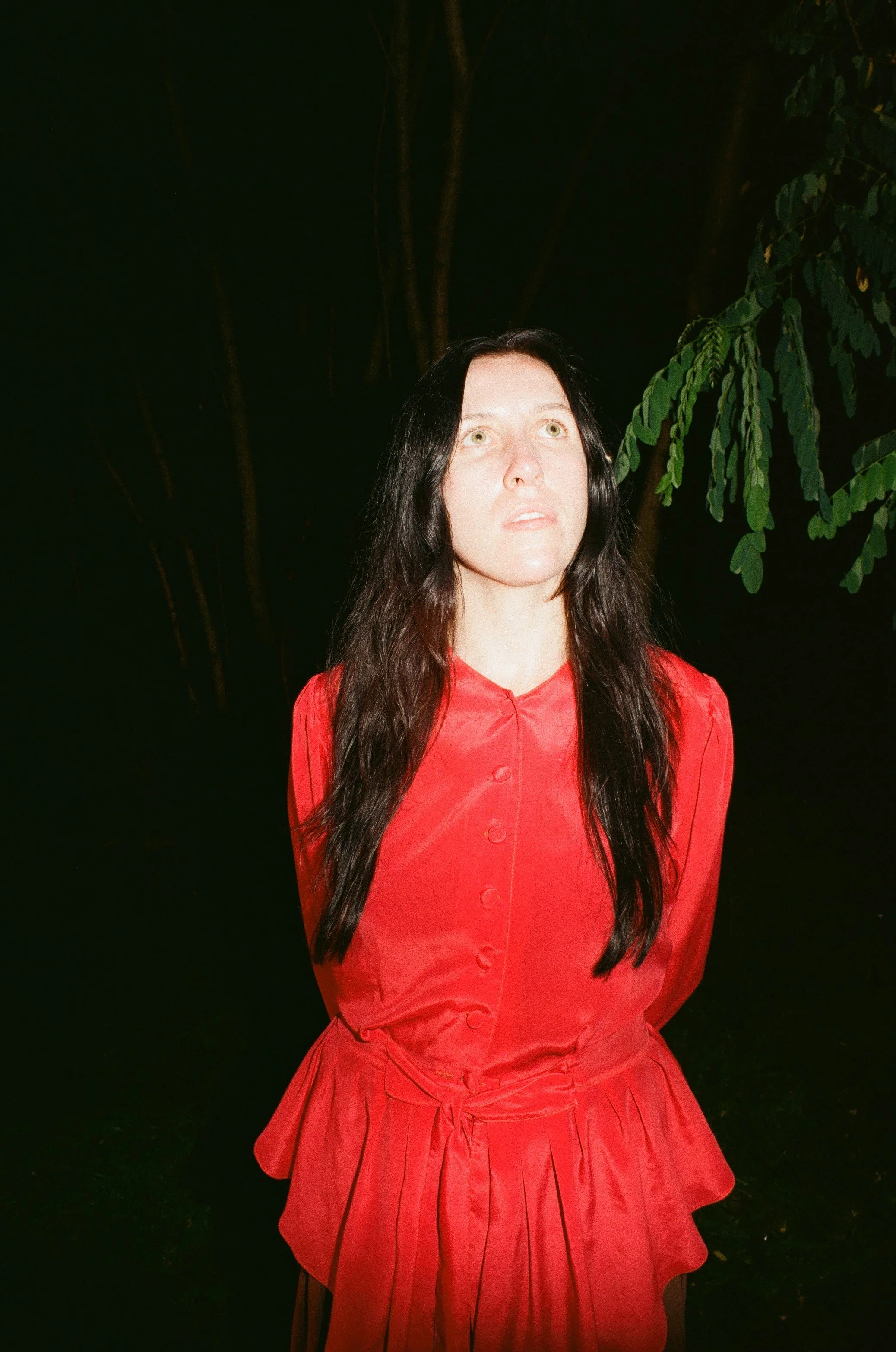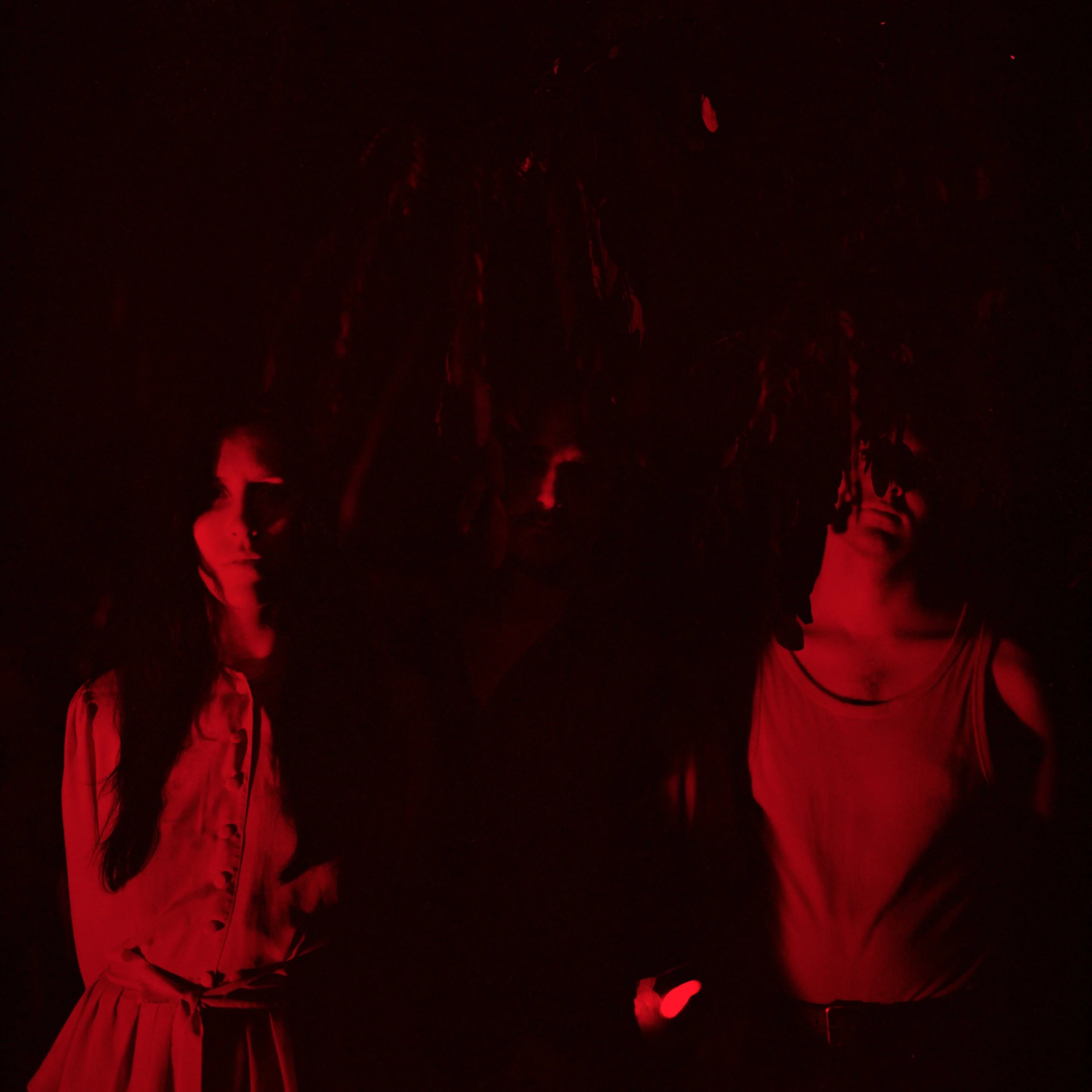DOG RACE
May 2025
‘ I’d known what I wanted to say, but I hadn’t known how to say it. ’
It’s just turned midnight by the time we’re photographing Dog Race. Their keyboardist, Dillon Willis, has just turned 27. We’re stood by an electric pylon and watching Katie Healy - their vocalist, and Shelley Duvall’s near-perfect likeness - flit between the low hanging branches of a tree with leaves that snap at her hair. It’s the buzz from the electricity - we’re standing too close and, since they were in Germany, haven’t heeded the security guard’s warnings. Her red prairie dress is the only thing we can see with any clarity.
Earlier that day I sat down with the band. They know each other well — it’s a dynastic affair in some sense, though I can’t quite pin down how — and alongside drummer Jed Fitzallen and guitarist James Kelly they’re keen to set the record straight, having felt somewhat misunderstood by the buzz around them following the release of a pair of perfectly produced singles. We talk for an hour, and then they reconvene for a set that ends with a haunting cover of Jean Beau’s Diamonds and Rust. Katie worries festival-goers will find it boring, but with her at the helm like a mermaid figurehead, the ideas seems impossible.
Their beginnings are curious. According to them, a shoegaze nine bass player called Connor brought them all together, named the band (after Blur’s Parklife), then quit. A plague meme left them kicking their heels, and their entrance into the South London scene was initially seductive but creatively alienating. In a sense, it’s no wonder they’re so enamoured of cults and individuals in their music.
But to their South London start.
Katie says they were trying to fit into the South London scene, to emulate that, and it never worked. ‘I used to go to venues and every band sounded so similar. I was bored of it so quickly that I didn’t want to be in that sort of outfit. I’d seen a band called Warmduscher, with an amazing front woman (Theresa Jarvis). They’re a mental band, so they’re not similar to us musically, but I hadn’t known this was an option. That was an inspiration, performance-wise. We were very inspired by the South London scene, even though it didn’t feel authentic to us.’
Will adds, ‘it’s dark, how can we fit in there? It just wasn’t working, I think the turning point was when we stopped trying to fit into what we were seeing around us. When we were trying to do something we used to listen to, that would excite us.’
So what changed for them? A change in location, or in their mindset? Katie thinks for a minute. Probably a change in state of mind. ‘Speaking just for myself, I was lacking a lot of confidence in my early 20s; I felt I was gravitating towards the scene because I thought I’d find what I’d not found, and I never did. So from a self-esteem point of view, it’s rocksolid. I’d never associate myself with other artists and musicians. It can be conducive to making your own, comparing constantly isn’t going to bring us closer to them sonically, and that’s not what we want.’
The band are quality over quantity, at the time of writing, it’s been ten months since their last release, and their oeuvre consists of just four songs. But they’re meticulous, perfectly produced little pieces.
Katie says at the beginning, their references were few and far between, but it was Jessica Winter, cult musician (and producer of their track Terror) who helped move them towards their current track. ‘Jessica opened us up to Christian Death and Bauhaus, she led us down the more Gothic route where we were like, oh my God, this is exactly what we want.’ Jed adds, ‘it was punk bands beforehand, and with Jessica it was everything from dreary to pop, hard-hitting stuff. It was a match made in heaven.’ From there they wrote the first faces. Katie says, ‘my mind went blank when they were recording that track. It’s very minimal and repetitive, but it’s one of my proudest moments. Then there’s a lot of German influences: Klaus Nomi, Kraftwerk, Nina Hagen, Xmal Deutschland and bands from the krautrock scene.’
Katie has a unique ability to make even the most innocent lines feel haunted; with this song as her thesis, ‘it’s obviously there’s what matter to her most. Will always says he never listens to lyrics, but it’s the first thing for me; it just makes such a difference.’ And what about when she’s writing her lyrics? She describes it as a sort of caricature of personal experience. In a way it’s storytelling. She and Jed both list David B. Garnufsky’s A Lover’s Discourse as an inspiration, for both its poetic prose and its obsession with the experiment of form and lyric. It’s all circular, somehow.
So are aesthetics important? Jed and Katie nod like Shining twins.
‘That point is thrown around a lot,’ Jed says, ‘and post punk is like that not because it’s easy. I think if anything we want to get away from labels.
‘We wanted to make something that as a whole – musically and visually – isn’t being seen at the moment, so we referenced back to ‘70s artists. The idea that spans after ages to complete refinement. I wanted to mention the Thin White Duke – that you need the complete package. We were talking earlier about the way the use of implants to put in his back – not punk or pop, say. But instead of a fear of aesthetic – not necessarily pop – of being an art piece.’
Their latest music video, Clarity, tells the story of a woman’s slow descent into a cult with an almost erotic intensity. Jed tells me the narrative stemmed from watching the way the psychology behind seduction. ‘We were just thinking about how it feels to be drawn in somewhere rather than just pushed.’
And what about the visual inspirations, the performance aspect?
‘Our inspirations were Wim Wenders and Stanley Kubrick,’ says Katie. ‘Screenplays have been a real inspiration for me. One of the lines from The Leaves was from the film with Joaquin Phoenix, You Were Never Really Here. With Joaquin in Inherent Vice, he’s trying to find salvation. I’d been looking for that for a while. I’d known what I wanted to say, but I hadn’t known how to say it. And suddenly it was, “I’ve find salvation, there is a premium.”’
They speak often about the way they want to be seen, to present themselves. This is important: they occupy the current music scene’s blank where they’d consider themselves perfectionists.
Jed laughs, ‘We’re not difficult!’
Katie moves to speak. ‘I think we’re perfectionists artistically, but not with ourselves. There’s a boundary in being a band of four people with their instruments. I’ll do hours a day trying to get the piano part right. We just mean that Dillon’s super analytical in his process. We’re not perfectionists – it’s not Thom Yorke – but we are perfectionists in that we’re maybe aware of what we don’t want to be. I think it’ll hinder us no more.’
Full article and more images in NEGATIVLAND - ISSUE TWO
Words: Kate Jeffrie
Photos: Kirkland Childs & Isaac Stubbings
Illustrations: Iris Ejlskov





